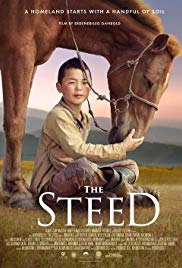
“The Steed” opens with a breathtaking and heart-pounding scene. A young boy climbs down a steep rock face high above a raging river. He calls out directions to the rope handler as he navigates to a huge white flower, which he plucks and puts in his bag with a smile. Then he gives directions to be hoisted back up, and the camera reveals that it is not a person the boy is communicating with, but his horse. In a very tense few moments, we see the bark “rope” getting sliced by the sharp rocks as the horse pulls the boy. But he makes it to safety, seemingly unaware of the potential danger. He holds the flower up to the horse with a huge grin and says, “Look!”
The gorgeous cinematography and emotional tug of this first scene sets up “The Steed” and draws us into the nomadic Mongolian culture that the film honors. The communication, trust and love between boy and horse is a thing of beauty celebrated in this sweeping drama that took Mongolian Director Erdenbileg Ganbold more than three years to make.
Indeed, the movie was a monumental undertaking, featuring thousands of horses and herd animals and support from local tribes. The Steed itself, Rusty, was played by three horses that were handpicked by the director and horse master and trained from birth for one aspect of the role — affectionate, athletic and aggressive — in order to create this one magnificent character. Rusty is like a Lassie for lovers of America’s other most favorite animal. He is not only a life companion for the boy, Chuluun, but also helps a series of other people and foils some villainous types.
Another amazing aspect of this film is the fact that the young Ariunbold Erdenebayar is not an actor, but an actual herder from the Mongolian countryside. After auditioning many child actors, the director was encouraged by family members to audition his young cousin. You won’t believe it when you witness his powerful performance.
At the beginning, we find that Chuluun had risked his life, quite happily and unknowingly, it seems, to get that flower to make a tea for his sick mother. After she dies, Chuluun is separated from his horse by a huckster, setting in motion the story of Chuluun’s search for Rusty and Rusty’s journey back to his homeland and family.
The exquisite story (based on an award-winning poem, “Brown Horse” by the Mongolian Poet Laureate Ch. Lkhamsuren) is matched by the spectacularly impressive Mongolian landscape, with its snowcapped mountains, expansive deserts and lush forests. Picturesque, poetic and emotionally powerful, “The Steed” has the feel of a classic.
Ganbold said in his director’s statement, “Mongolians cannot be imagined without their horses. The Mongolian empire encompassed two-thirds of the known world because of this sacred bond between horse and man. The horse was the basis of war, trade and sustenance, even our own spiritualism.”
“The Steed” is the fourth film to be submitted by Mongolia to the Oscars® since 2003 and is produced by Alexa Khan, one of the few female producers in the country, Ganbold and Trevor Doyle, along with U.S. Co-Producer Wil Masisak. It won the Spirit of Cinema Award at the 26th Oldenburg Film Festival and the Best Feature Film at the 23rd San Diego International Film Festival.
“The Steed” is something magical, even more so because it captures a real culture and landscape. Watch the trailer, and be hooked!
—Julie Riggott, Culture Spot LA
“The Steed” will screen at the Palm Springs International Film Festival in January, dates TBD. Check https://www.facebook.com/threeflamespictures/.





